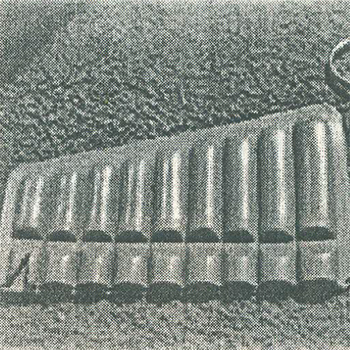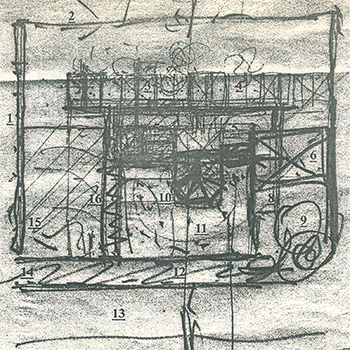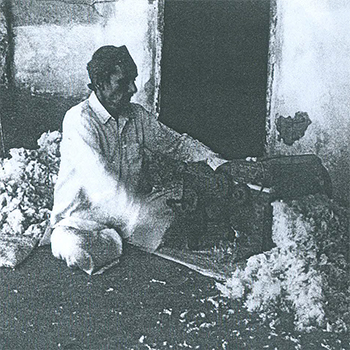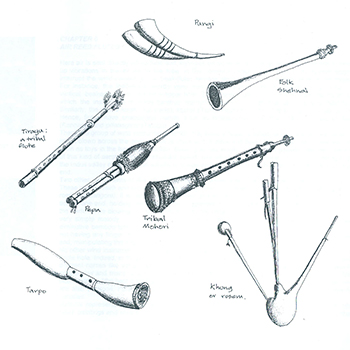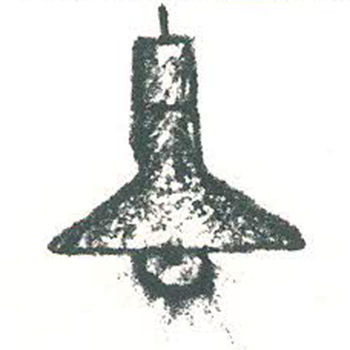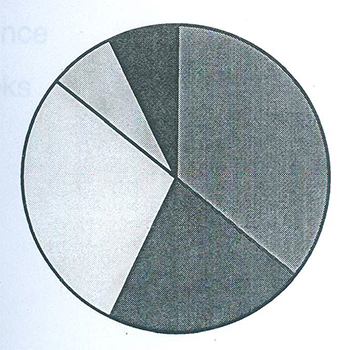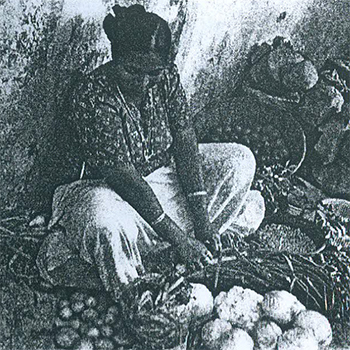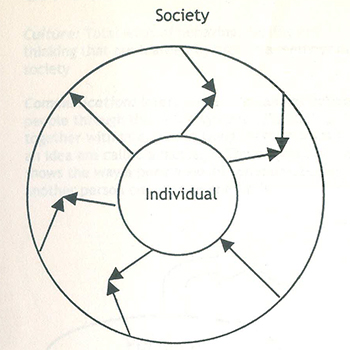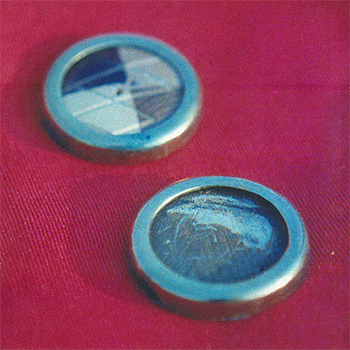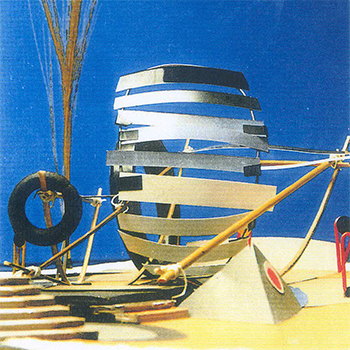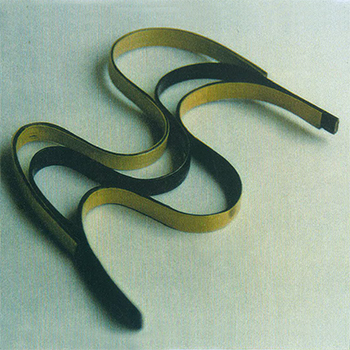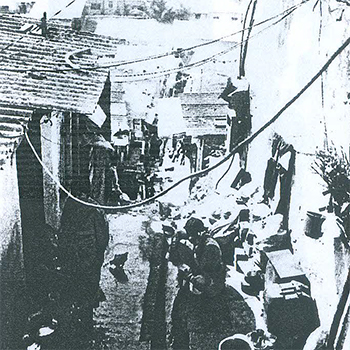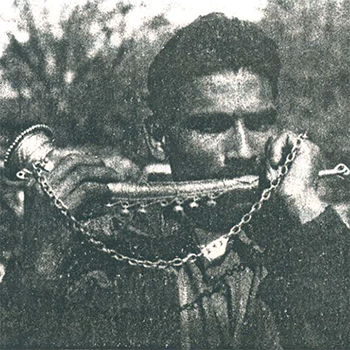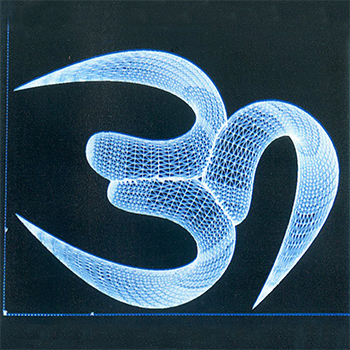Product Design
Batch 1997-1999
(16 items)
Product DesignBatch 1997-1999
(16 items)
(16 items)
by Anand P Rajhans
Whistle-making in terracotta is a dying art. Only a few potters from Patan are making these whistles for sale. To make a whistle in terracotta is a difficult thing, from the potter's point of view. Potters do not have a particular method for making them. Many people do it through experience and skill. Recently, there was an article published in a Russian book ("Russian Folk Style Figuring" by Genndi Blinov). That article shed light on the present situation of potters in Russia. It Says-Will Folk Craft Survive?
"This is a question that arises quite often. Comparing the old Filimonovo, Kargopol, or Dymkovo toys with their modern counterparts that one can buy in craft stores, one cannot help but notice that the new toys are usually at quite a disadvantage. Not so long ago, craftsmen managed to create a brilliant effect using just two or three colours. The simple designs on Vyatka toys, derived from the clothing of the period or ancient pagan symbols, were eminently suitable for clay. They were executed with light mastery and always bore the individual mark of their creator. Recently made folk toys are often painted garishly in colours that fail to combine harmoniously. This does not mean, of course, that the young artists have produced nothing valuable, but as a rule, modern ware from Vyatka, Kargopol, or Filimonovo is inferior to its predecessors. One is compelled to conclude that the craft is declining. Art critic Vladimir Stasov expressed similar fears nearly a century ago. He wrote sadly that folk craftsmen's objects for everyday use were rapidly disappearing to make way for new ones, which, while more serviceable and convenient, lacked the originality and loneliness of their older counterparts. Stasov pointed out that it was time to start collecting, describing, and reproducing those objects, for in his opinion it was a matter of decades or even years before they would disappear without a trace. The time for folk craftsmen is indeed passing. Young people do not show much interest in crafts. They prefer to become drivers, doctors, airline hostesses, psychologists, or actors. But even if a young person takes up a craft and proves talented, he or she is still our contemporary, with a modern mentality and perception of the world. He or she may master specific techniques and, at best, grasp the mood of the old craftsman embodied in his work. But that is all. Under modern conditions, the imagery typical of folklore, that kernel of genuine folk art is bound to be lost. The Soviet state does a great deal to preserve folk crafts and give new impetus to the development of old art centres. Nearly 200 crafts have already been revived, such as toy making in Kargopol, Dymkovo, Filimonovo, Bogorod Skoye, Semyonov, and Abashevo. In the villages of Polkhovsky Maidan and Krutets, toy making began to develop very recently, a fact that obliges one to be cautious when making prognostications concerning the destiny of folk art. The old crafts may also assume new significance if they manage to transcend the production of souvenirs. Art critics note that even now, objects made by folk artists, like pottery, baskets, and lace, can find a use in everyday life. Folk art as a reflection of a certain perception of the world may be coming to an end, but some of its branches continue to exist and will most likely exist as long as poetic perception itself, which draws on the lifestyle in the countryside, agricultural labour, old traditions, and proximity to nature, all of which are still a part of rural life. There is no reason to suppose that this will suddenly cease to be reflected in objects d'art. A heartening sign is a revival of interest in folk crafts not only in towns but among country people, who until recently tended to attach importance to urban culture only, treating the work of their fellow villagers with ironic neglect. This welcome change has been brought about by the higher cultural level of the rural population, the efforts to popularise folk art by arranging exhibitions on all levels, and the encouragement of folk artists, many of whom have even been awarded state prizes. The revival of interest in traditional folk art, especially in the place of its origin, and appreciation of its value are certain to bear fruit. One should like to believe that the folk crafts will not confine themselves to the production of souvenirs and that they will promote understanding among nations. The language of art needs no interpreter. For a student of the history of a nation, nothing can be as revealing as folk art. And better knowledge of each other is something that we all need in an epoch that has made it imperative that relations between the peoples of the earth be based on mutual trust and respect".
The situation of folk craft in India is similar. The new generation of potters is not interested in playing with clay as their means of livelihood. It is a tentative attempt in the direction of reviving the dying art of whistle making.
by Anshuman Singh
The purpose of the experiment was to study the role and potential of mental imagery in the architectural design process. To study the use of only mental imagery as a feedback while designing in the absence of other media, viz., sketching. This experiment is a continuation of previous research on industrial designers. The experiment was made to study architects to ascertain the role of mental imagery, which is different in scale and complexity than industrial design.
This was achieved by using an experienced architect and blindfolding him during the act of design. The results achieved clearly indicate that he was able to use mental imagery to assist him in the design
by Avinash Bhalerao
Logical and practical thinking always leads to better solutions to the problem. We always try to be self-sufficient and find our own way forward. We think about something, dream about it, and then make it a reality. We built our environment around us with the resources available. We try to make the best use of limited resources to get maximum output and comfort. For day-to-day use, we redesign the environment through intelligent improvisation, adoption of processes, substitution of materials, and use of natural materials. Without taking help from highly developed technology, science, etc.
Because of the demands of daily life, the utility of the product for that time, event, or occasion takes precedence over its comfort and aesthetics. where the function or usability is more important than the visual aspects.
Again scarcity of materials, resources, and money leads to very immediate and simple solutions to the problems.
by C. Himasunder Rao
We almost always hear a variety of sounds. The pleasant sounds are called "musical." A composition of pleasant sounds makes music. Music has a tremendous influence on people’s lives. There is music for nearly every occasion and event. Today, music and musical instruments have become so sophisticated and specialised that we rarely ponder the roots of their existence. However, if we searched, we would discover the significance of the relationship between music and people's cultural lifestyles.
Music is surely more evident with instruments. Right from Phantom’s "tom-tom" drums to the mumbling of the bumblebees, we find the roots of music. Bird whistles and insect drones demonstrate the concept of musical effects and the origins of their creation. Though very versatile, the simplest of all instruments is the flute. It is the wind instrument closest to the human voice. It is an indoor as well as an outdoor instrument. It is very portable and reasonably priced. The punch of the flute is its ability to produce sound. In most wind instruments, air is made to vibrate and is the cause of tones. The flute belongs to the family of woodwind instruments. The flute is one of the world’s oldest musical instruments, and it is also one of the simplest. It is essentially a hollow chamber equipped with a blowhole for introducing acoustic energy. The flute is the only musical instrument that is purely acoustical, requiring no vibrating membranes, strings, reeds, or surfaces for the production of sound, and it has been developed to include a variety of wind instruments. Wind instruments, by their very nature, do not need recurring expenditures to maintain them. It is the most commonly encountered musical instrument. It is considered the common instrument of humanity. This instrument occurs internationally and is not limited by geographical barriers.
This report concentrates essentially on the Indian aeroplanes; its growth, and its social influence. In the history of world music, the Indian flute may be said to be one of the first instruments on which classical music was played. Among concert instruments, the flute enjoys the same dignity and status as the veena. Folk music has a definite character and style of playing the flute. The flute enhances the charm of music and the theme of the occasion. The distinct music that evolved in the region over time has helped to establish the style culturally. For example, the music of the hills is distinctive from the kirtans of the south.
by Hari Tulasi
Traditionally, the manufacturing industry has been concerned with product design. The manufacturing industry may be at the centre of this process, but the design of its products is influenced by many other considerations and activities. What all these influences have in common is the extent to which they add value to the product and thus contribute to its gross margin performance. In fact, product design might be described as "designing for gross margin by extractive manufacturing, distribution, and retailing."
Products are added to the product portfolios of firms in a variety of ways. Many types of strategies—innovative and imitative, offensive and defensive, entrepreneurial and bureaucratic—internal development and external acquisition—are used to add new products and adjust existing ones. These strategic decisions have to be made in a turbulent and risky environment. Offsetting the uncertainty and risks are the rewards of good strategy: products, market dominance, customer loyalty, and invulnerability to outside forces. This in turn increases revenue and returns; it preempts sources of risk such as competitive actions and regulatory constraints.
by Imtiyaz Khatib
The visualisation of system status and ongoing processes has enhanced user understanding. A user's interaction with a CAD application lies in how the system is easily perceived via its graphical user interface. An attempt is made to gain firsthand information about the variability and usability of icons, contextual to their application. The study's goal was to look into the factors that influence user perception of icons and their relational aspects.
The methodology adopted was based on comprehending the underlying concepts of GUI in CAD software by analysing and evaluating icons that were selected from various contexts, viz., visualisation, drafting, analysis, and modeling. The icons were tested for critical evaluation amongst designers, graphic visualizers, users of the same software, architects, engineers, etc. to understand their perception of variability.
by Jayraj Patil
Today, when the process of liberalisation is under way, many changes are taking place in Indian industry. Company identities are metamorphosing, brands are revamping & business perception of design is shifting from the domain of the effete to a valid concern for even the most hardheaded managers.
Product design is the final destination of industrial design and engineering design. The former is concerned with aspects of the product that relate to the customer or user, especially appearance and styling; the latter concentrates on the structure or function of the product and its economic manicure. However, the skills required in the practise of industrial design frequently overlap those of engineering design and, sometimes, of other related disciplines such as ergonomics.
Designing may be viewed as being concerned with the preparation of appropriate solutions to marketing problems. These problems may be explicit or implicit; in either case, a key activity in designing is to review the associated symptoms or circumstances and accurately define or redefine the problem. Then analysis, iteration, and simulation are used to drive a feasible solution.
As part of such a process of design, many activities may be involved, including generating novel concepts, reviewing and modifying existing concepts, carrying out experiments, building samples, and seeking the constructive advice and judgement of others. Consequently, those engaged in this work must possess skills of creativity, analysis, synthesis, and communication, as well as knowledge of technical data, existing solutions, and current and future trends in design.
by Kulkarni Anand A
Mumbai is a recent development. The history of Mumbai can be traced up to 400 years. Gorai's residents are Katch migrants who arrived around 500 years ago. They came here and settled here. They have a strong Katchean cultural foundation because they migrated from Katch. The culture is related to their profession, fishing. Since their background is Hindu, we can see some traces of Hindu culture and traditions in the lives of these people.
by Munindra Nath Chakravarty
Though we surround ourselves with external support systems indoors and out, we all venture out of our habitats and operate as nomads, independent of these systems, for some portion of each day. Our clothing is a portable environment that can regulate body temperature, afford security and privacy, and express individual identity. Our possessions inform, sustain, and entertain us, as well as provide symbolic or physical access to valued resources.
The prospect for portable and wearable devices that extend the human mobile nature lies in the ambiguous zone between clothing and the things people carry.
by Neeti Gupta
"Button Forms" as a special project defines the creative way of looking at buttons. Buttons have always been a part of our lives since childhood. They are seen in various shapes, forms, colours, textures, materials, and sizes. They form a vital part of our dresses, both as fashion accessories and in apparel design.
Buttons made of bamboo and other natural materials have taken a back seat in the market after the flood of plastic buttons, which are available in a variety of designs. However, designer clothes have opened a market for buttons in ceramics, wood, bamboo, and other natural materials. In this project, one also looks at the various potential markets for marketing these button forms.
by Sachin Behere
Intertextualilty is a theme of the 9th OSAKA international design competition for design. This project works upon the theme and contains two parts. The first is the study of situations that have demonstrated intertextuality. The second part is a design approach that exemplifies the theme.
The Theme: Design is always studied in terms of its roots, context, and perceptional value. The design activity generates itself out of a certain background, and the background creates the form-giving forces. When we consider what makes a design, we can find a wonderful range of experiences and expertise that satisfy sensory and material needs. It is interesting to know what makes a design retain its context while still leaving the viewer freedom of choice. There could be one, three, or numerous items. The idea here is to study the combination of roots in design. The purpose of this study is to find out all sorts of related/unrelated things that get associated with the design activity. The focus will be on understanding how two things come together to form a base for design. Intertextuality is the ability to connect disparate things and blend them into a design situation or potential.
The scope of work: intermixing can be attained on all levels. cultures, generations, sensibilities, and ways of thinking. The union can occur between media, materials, disciplines, thought processes, or viewpoints. This project focuses on two or more disciplines and therefore attitudes that come together and create an event, which is an interesting design situation.
by Sameer Chavan
The idea for such a topic is inspired by the recent trends in celebrating events. Now what are such events?
Events are like ceremonies, occasions, functions, and festivals. They all have their own significance. They are celebrated with some rituals, and in celebrating them, there are some products that are specific to the event. What exactly are products?
Products are those items, that are important at such events. They are given on these occasions. They could be active for the duration of the event or for the rest of time. They have a special position in the event.
by Shilpa Tikale
Bamboo is a cultural feature of Southeast Asia. No country in the region is without an indigenous bamboo flora. Its plethora of essential uses has led to the use of terms such as "bamboo culture," "green gold," "poor man’s timber," and "bamboo-friend of people".
Bamboo is the most versatile forest product, and its potential can be harnessed in the service of mankind. It is one of the most important renewable natural resources of humble grass, which has the capability to reduce maximum biomass per unit area and time as compared with other forest plants.
by Sudhir K Bania
Following its consolidation as one large island of greater Bombay from a group of seven small islands, the city went on to become the country's financial capital. Due to the fast pace of modern life and the growth possibilities available in the city, immigrants from all parts of the country started encroaching on the city. Thus, suburbs began to form. Every group of immigrants had to settle outside the city limits due to a lack of space. Soon, these areas developed to a certain level of urbanisation and became part of the city. Thus, the city expanded. Hence, given a settlement in the suburbs of the city, one can roughly judge when people might have started settling in that area.
As modernization accelerates, immigrants who have settled in the city find themselves having to compromise on their ethnic values over modern values for the sake of sustenance and survival. This implies that earlier immigrants were able to establish more ethnic values in the city than the current immigrants.
by Sushilkumar Wankhedkar
"What is a musical instrument?" While one attempts to give an answer, however vague, to the question, the query implies others: "What is music?" and "What is the origin of music?" At first glance, the latter appears to be easier to answer.
The probings are important, because the concepts of musicology and organology are, in their present state, highly sophisticated. For, at the earliest stages of man, music, noise, speech, and dance are all an undivided condition of motor impulse. Is, for instance, a screech accompanying primitive or tribal "dance" music? Yet it has a "rhythmic" and "melodic" quality, or is more strictly an affective spell, different from speech. It therefore seems to me logical to take an undifferenciated sound material and use it in one of the communicative processes—both in humans and nonhumans—which later, in men, get bifurcated into speech and music, the former as a tool of conscious alphabets such as "notes," "chords," "ragas," and so on.
Starting at the other end of the spectrum, as it were, Hindu philosophy expresses the entirety of acoustic material, as well as non-acoustic material, in terms of the One Sound—the Premordial Vibration known and variously known as ivada Brahms, Omkara, and so on; thus, the metaphysical associations of the flute (with Krishna), veena (with Saraswathi), and damaru (with Siva).
The primaeval nebulous state of music is reflected in the early instruments, which do not produce any definite musical sounds of this type, such as scrapers, rasps, and seed rattles. The sound emitted by serapers is undeniably "noisy," and the instrument itself is found mostly with primitive tribes, such as the American Indian's antelope horn scraper and Mexico's Omichicahuaztli; in our own country, we have doddurajan of the Savaras and Kokkara of the Kanikars.The earliest instruments, again, are both musical and non musical in function. Musically, the association is inseparable from dance and hence also rhythm. Dried fruit rattles the Kaniyari dander of Oraons, or, more primitively, fruit shells tied to the waist, are such musical accompaniments of the early stages.Later on, we have fi sticks, slit drums, plates, bars, drums, veeras, and flutes. The functions of instruments were also a feature of early society. The coiicli was not only an announcer of battle but also a container of sacred water for ablution. The Nagcira and the Dliumia were also battle drums Membranophonics have been used as tools for signaling; the most famous ones are the Bengue. Riittray, for instance, has shown that "the difference in pitch between two skin drums used for transmitting news corresponds to the high and low pitches of ordinary speech." The Savaras of Orissa have a legend wherein one Kittung "invents" a drum and a brass gong to announce a funeral or a wedding.
What, then, is a musical instrument? Most broadly put, it is any material used for producing sound in music, but we have already noted its hazy origins. In this sense, the oldest instrument is the human body itself, particularly the voice. Indeed, it has been referred to as Gatra Veena, the body Veena, in our ancient musical texts. Clapping of hands, beating on things and buttocks, stamping on the ground—all such auditory bodily actions are the first instruments. It is interesting to note that the hand used as a counting adjunet to Vedic chanting—no sound is produced at all in this process—is called hasta.
by Tushar Dani
Every day, nature is evolving and creating various kinds of complex forms with elegance and beauty. Some examples of complex forms include the process by which sea creatures build shells and mushrooms.
The sea mollusk generates the shell to have protection while living. The shell also gets developed in a particular manner, i.e., layer by layer, generating a spiral form with a variety of textures and patterns on it.
It was this idea that was then further developed for doing this project. No other man-made manufacturing process can make such complex 3D forms like nature can. The new RP process develops a prototype in the same manner as that of nature, i.e., by depositing the molten material layer by layer. So the approach of making explorations in 3D letterforms was suggested in order to get some similarity between the natural process and the new technology.
Another attempt was made to produce the prototype with thin walled structures or shell structures so as to know the capability of the RP machine in terms of optimum material utilization.
